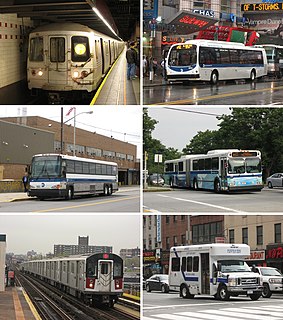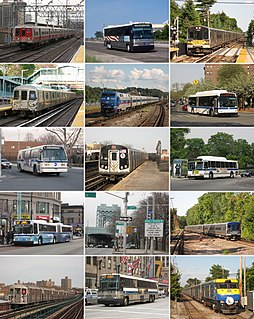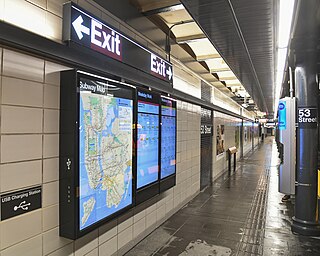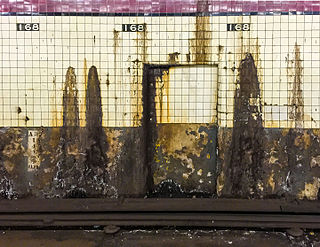
The New York City Subway is a rapid transit system owned by the City of New York and leased to the New York City Transit Authority, an affiliate agency of the state-run Metropolitan Transportation Authority (MTA). Opened on October 27, 1904, the New York City Subway is one of the world's oldest public transit systems, one of the most-used, and the one with the most stations, with 472 stations in operation. Stations are located throughout the boroughs of Manhattan, Brooklyn, Queens, and the Bronx.

Metro-North Railroad, trading as MTAMetro-North, is a suburban commuter rail service run by the Metropolitan Transportation Authority (MTA), a public authority of the U.S. state of New York and under contract with the Connecticut Department of Transportation. Metro-North runs service between New York City and its northern suburbs in New York and Connecticut, including Port Jervis, Spring Valley, Poughkeepsie, Yonkers, New Rochelle, Mt. Vernon, White Plains, Southeast and Wassaic in New York and Stamford, New Canaan, Danbury, Waterbury, and New Haven in Connecticut. Metro-North also provides local rail service within the New York City boroughs of Manhattan and the Bronx.

The New York City Transit Authority is a public-benefit corporation in the U.S. state of New York that operates public transportation in New York City. Part of the Metropolitan Transportation Authority, the busiest and largest transit system in North America, the NYCTA has a daily ridership of 8 million trips.

The Metropolitan Transportation Authority (MTA) is a public benefit corporation responsible for public transportation in the New York City metropolitan area of the U.S. state of New York. The MTA is the largest public transit authority in the United States, serving 12 counties in Downstate New York, along with two counties in southwestern Connecticut under contract to the Connecticut Department of Transportation, carrying over 11 million passengers on an average weekday systemwide, and over 850,000 vehicles on its seven toll bridges and two tunnels per weekday.
The Triborough Bridge and Tunnel Authority (TBTA), doing business as MTA Bridges and Tunnels, is an affiliate agency of the Metropolitan Transportation Authority that operates seven toll bridges and two tunnels in New York City. In terms of traffic volume, it is the largest bridge and tunnel toll agency in the United States, serving more than a million people each day and generating more than $1.9 billion in toll revenue annually as of 2017. As of 2018, its budget was $596 million, funded through taxes and fees.

The 7 Flushing Local and <7> Flushing Express are two rapid transit services in the A Division of the New York City Subway, providing local and express services along the full length of the IRT Flushing Line. Their route emblems, or "bullets", are colored purple, since they serve the Flushing Line.
The 7 Subway Extension is a subway extension of the New York City Subway's IRT Flushing Line, which is served by the 7 local and <7> express services. The extension stretches 1.5 miles (2.4 km) southwest from its previous terminus at Times Square, at Seventh Avenue and 41st Street, to one new station at 34th Street and Eleventh Avenue. A second station at 10th Avenue and 41st Street was dropped from the plans in October 2007. The entirety of the extension is located within the New York City borough of Manhattan. The extension, a key part of the Hudson Yards Redevelopment Project, is expected to bring business and entertainment into the area, as well as aid redevelopment of nearby Chelsea and Hell's Kitchen, located around the Long Island Rail Road's West Side Yard. The extension also serves the nearby Jacob K. Javits Convention Center.

Most trains on the New York City Subway are manually operated. The system currently uses Automatic Block Signaling, with fixed wayside signals and automatic train stops. Many portions of the signaling system were installed between the 1930s and 1960s. Because of the age of the subway system, many replacement parts are unavailable from signaling suppliers and must be custom built for the New York City Transit Authority, which operates the subway. Additionally, some subway lines have reached their train capacity limits and cannot operate extra trains in the current system.

The South Ferry/Whitehall Street station is a New York City Subway station complex in the Manhattan neighborhood of Financial District, under Battery Park. The complex is shared by the IRT Broadway–Seventh Avenue Line and the BMT Broadway Line. It is served by the 1 and R trains at all times, the N train during late nights only, and the W train during weekdays only.
Elliot "Lee" Sander is the new President of Bombardier Transportation, Americas region effective November 19, 2018. Previously, he was Managing Director, Global Transportation and US Infrastructure at Hatch Ltd, a global multidisciplinary management, engineering, and development consultancy. He is also the Senior Independent Director of the board of National Express, a UK-based global operator of rail, bus, para-transit, and school bus services. Sander is Chairman Emeritus of the Regional Plan Association, Vice-Chairman of the Greater Jamaica Development Corporation, and on the Board of the Leo Baeck Institute. Sander is the founder of the Rudin Center for Transportation Policy and Management and Management at the Robert F. Wagner Graduate School of Public Service at New York University. He also co-founded the Empire State Transportation Alliance (ESTA).

MTA Regional Bus Operations (RBO) is the surface transit division of the Metropolitan Transportation Authority (MTA). It was created in 2008 to consolidate all bus operations in New York City operated by the MTA. As of February 2018, MTA Regional Bus Operations runs 234 local routes, 71 express routes, and 20 Select Bus Service routes. Its fleet of 5,725 buses is the largest municipal bus fleet in the United States and operates 24/7.

Jay Walder was the CEO of Virgin Hyperloop One, an American transportation technology company. He has been the CEO of Motivate, a bike sharing company, and of the Hong Kong transit company MTR Corporation (MTRC), before resigning from that position in July 2014.

The 2013 New York City mayoral election occurred on November 5, 2013, along with elections for Comptroller, Public Advocate, Borough President, and members of the New York City Council. The incumbent mayor of New York City, Michael Bloomberg, a Republican-turned-Independent, was term-limited and thus unable to seek re-election to a fourth term in office.

Joseph J. Lhota is an American public servant and a former politician who served as the chairman of the Metropolitan Transportation Authority and was also a former deputy mayor of New York City. He was the Republican nominee in an unsuccessful bid for the 2013 election for Mayor of New York City. In January 2014, he became senior vice president, vice dean, and chief of staff at NYU Langone Medical Center. In 2017, he returned to the chairmanship of the MTA, but would not run the authority day-to-day. He resigned from that position in 2018.

Andy Byford is a British civic employee whose career has been defined by serving in chief positions in a number of top public transport corporations around the world.

Patrick Joseph Foye is an American lawyer who served as Chairman and CEO of the New York Metropolitan Transportation Authority (MTA). Prior to this role, he served as President of the MTA and Executive Director of the Port Authority of New York and New Jersey.
William John Ronan was an American public servant and academic who founded and served as the first chairman of New York City's Metropolitan Transportation Authority, from 1968 to 1974. He subsequently served as chairman of the Port Authority of New York and New Jersey from 1974 until 1977 and remained on the board of the Port Authority until 1990. Prior to entering state government as a key aide to Governor Nelson Rockefeller of New York in 1958, he was a professor of government at New York University and served as dean of NYU's graduate school of public service from 1953 to 1958.

Since the late 20th century, the Metropolitan Transportation Authority has started several projects to maintain and improve the New York City Subway. Some of these projects, such as subway line automation, proposed platform screen doors, the FASTRACK maintenance program, and infrastructural improvements proposed in 2015–2019 Capital Program, contribute toward improving the system's efficiency. Others, such as train-arrival "countdown clocks", "Help Point" station intercoms, "On the Go! Travel Station" passenger kiosks, wireless and cellular network connections in stations, MetroCard fare payment alternatives, and digital ads, are meant to benefit individual passengers. Yet others, including the various methods of subway construction, do not directly impact the passenger interface, but are used to make subway operations efficient.
The New York City Mayor's Office of Management and Budget (OMB), formerly New York City Office of Management and Budget, is the New York City government's chief financial agency, organized as part of the New York City Mayor's office. OMB staff, under the direction of the Mayor and the Budget Director, assemble and oversee the expense, revenue, and capital budgets for the city. The City of New York funds the activities of approximately 70 agencies with more than 300,000 full-time and full-time equivalent employees.

In 2017, New York Governor Andrew Cuomo declared a state of emergency for the Metropolitan Transportation Authority (MTA) due to ongoing reliability and crowding problems with mass transit in New York City. This order applied particularly to the New York City Subway, which was the most severely affected by dilapidated infrastructure, causing overcrowding and delays. With many parts of the system approaching or exceeding 100 years of age, general deterioration could be seen in many subway stations. By 2017, only 65% of weekday trains reached their destinations on time, the lowest rate since a transit crisis in the 1970s. To a lesser extent, New York City buses operated by the MTA were also affected. Both the subway and the buses are run by the New York City Transit Authority (NYCTA), a subsidiary of the MTA. A separate crisis at Penn Station affected the routes of the three railroad agencies that provided service into the station. Media outlets deemed these crises "the summer of hell".














